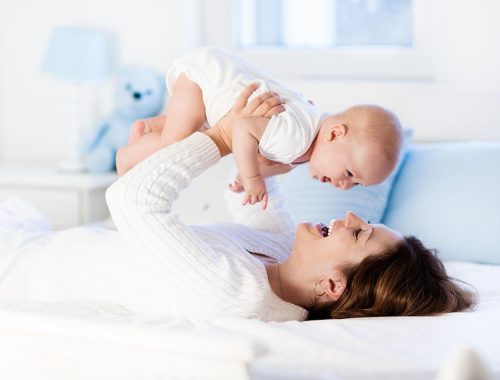Every mom knows that a baby’s belly just begs to be kissed. No diapering or outfit change should go without a quick nuzzle, especially in the adorable little cup of their navel. But moms of newborns frequently look at their infant’s still-healing navel stump and go, “Ew! What do I do with that?” Although it may look gross and intimidating, don’t be afraid. Taking care of the umbilical cord is easy, and thankfully, it doesn’t take long until your baby’s tummy looks just like you’re accustomed to seeing on everyone else’s babies.
When the umbilical cord is clamped and cut, severing the lifeline between you and your newly-minted bundle of joy, it’s tied off by the doctor–hopefully tightly enough. Some babies end up with “outies” because a bit too much room was left at the base of the umbilical cord knot, so a bit of the abdominal wall bulges outward into the cavity and makes the navel convex rather than concave. There’s no medical problem associated with a protruding belly button, but if you’re unhappy with your baby’s outie, speak to your pediatrician and see what can be done, if anything.
The doctor will always leave a bit of the umbilicus extending beyond the knot, to give it room to heal, usually about an inch or so of dangly tissue. It starts out as yellowish-green but progresses to brown and ultimately black, when it has crinkled up and is ready to fall off. Although it looks pretty awful, the umbilical cord has no nerve tissue, so your baby’s in no pain whatsoever. The only thing a mum needs to do about the stump is keeping the area clean and dry. Here are some belly-button hygiene tips.
- It takes about 2 weeks or so for the stump to completely dry up and fall off. Until then, keep the area as clean and dry as possible, and don’t cover it up if you can help it. If you can find them, get newborn diapers which have the nifty cut-out notch on the front for just that purpose.
- In hot weather let your baby “let it all hang out” as often as possible, exposing the tummy to air circulation. This helps speed things along.
- Doctors used to tell mothers to clean their babies’ umbilical stumps with alcohol, supposedly to speed up the drying-out process. However, new research shows that it’s best if it’s just left alone.
- Until the navel string falls off on its own, try to minimize submerging baby in the tub. Try to stick to sponge or washcloth baths. If you need to use the tub because your child is especially dirty, don’t submerge the tummy.
- When bathing the baby, don’t wash the stump unless it’s become sticky or dirty. In those cases, clean it off gently with baby soap and water, and then dry it carefully with a soft cloth or by fanning it.
- Don’t give in to the temptation to pull it off or aid in its removal, even if it’s just clinging by a thread. It will fall off on its own when it’s ready to.
- If the area around the base of the navel appears red and swollen, oozes foul-smelling fluid or discharge, or bleeds continuously, it might be infected. Take your child to the doctor as soon as possible, as newborn infections can be dangerous.



